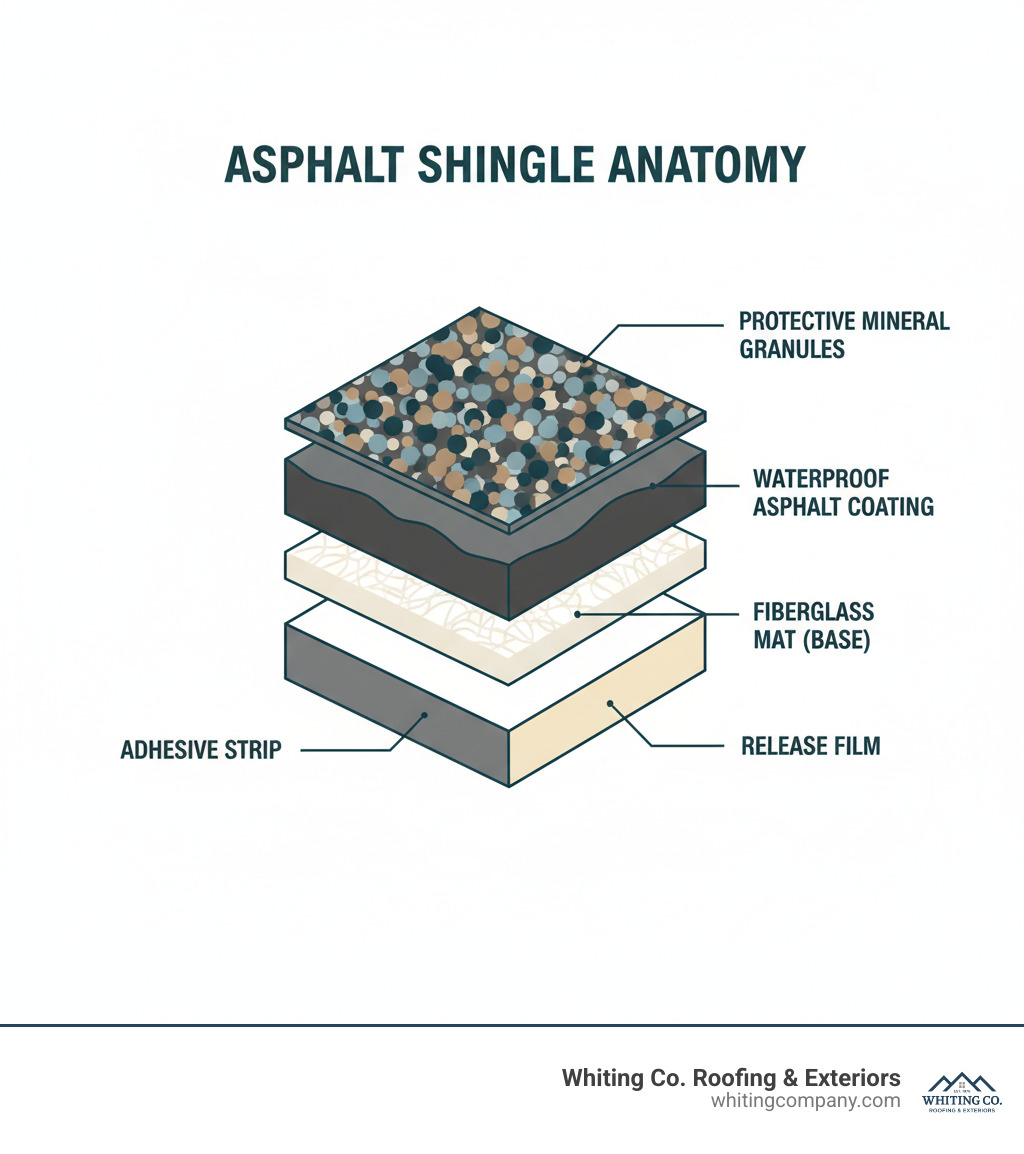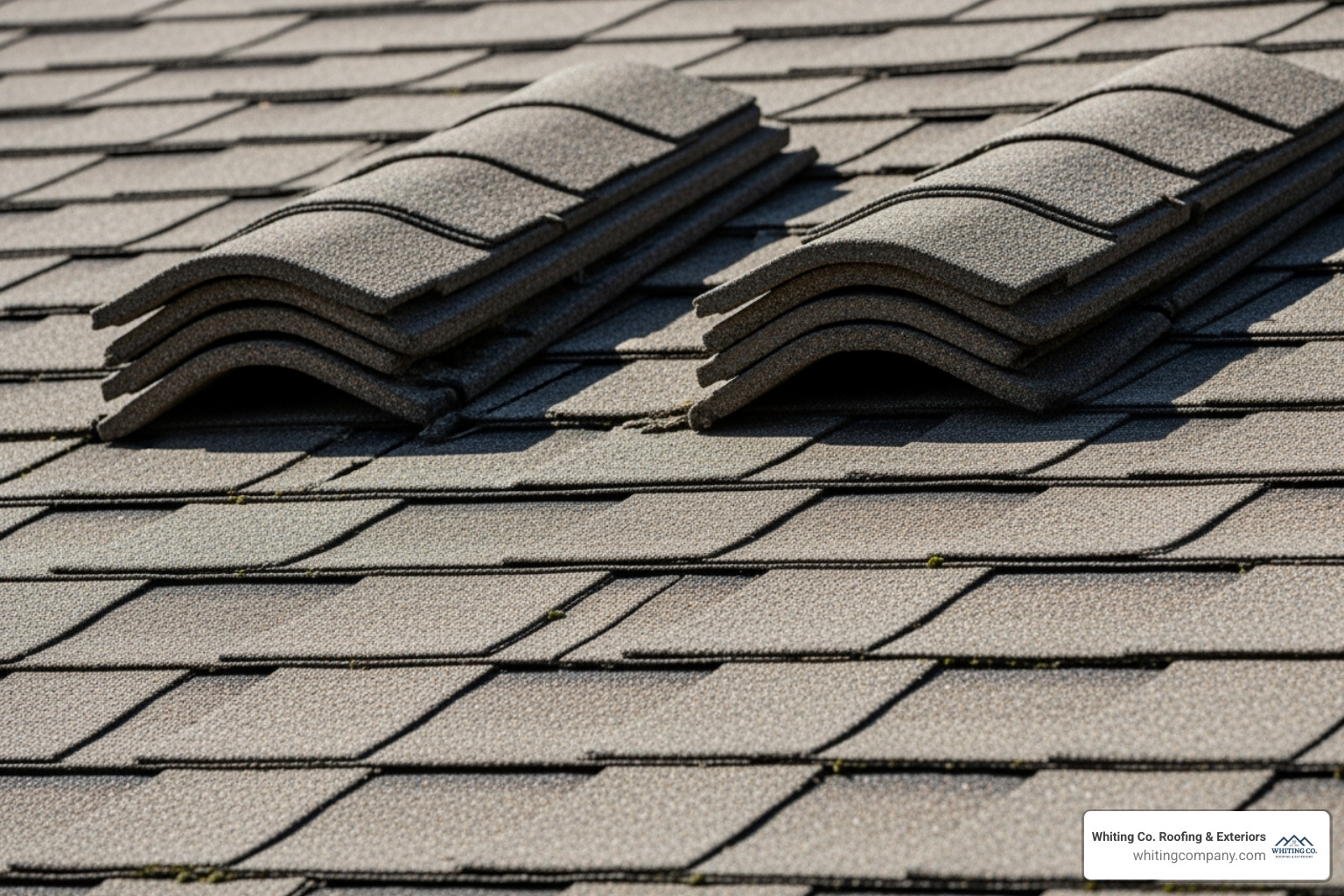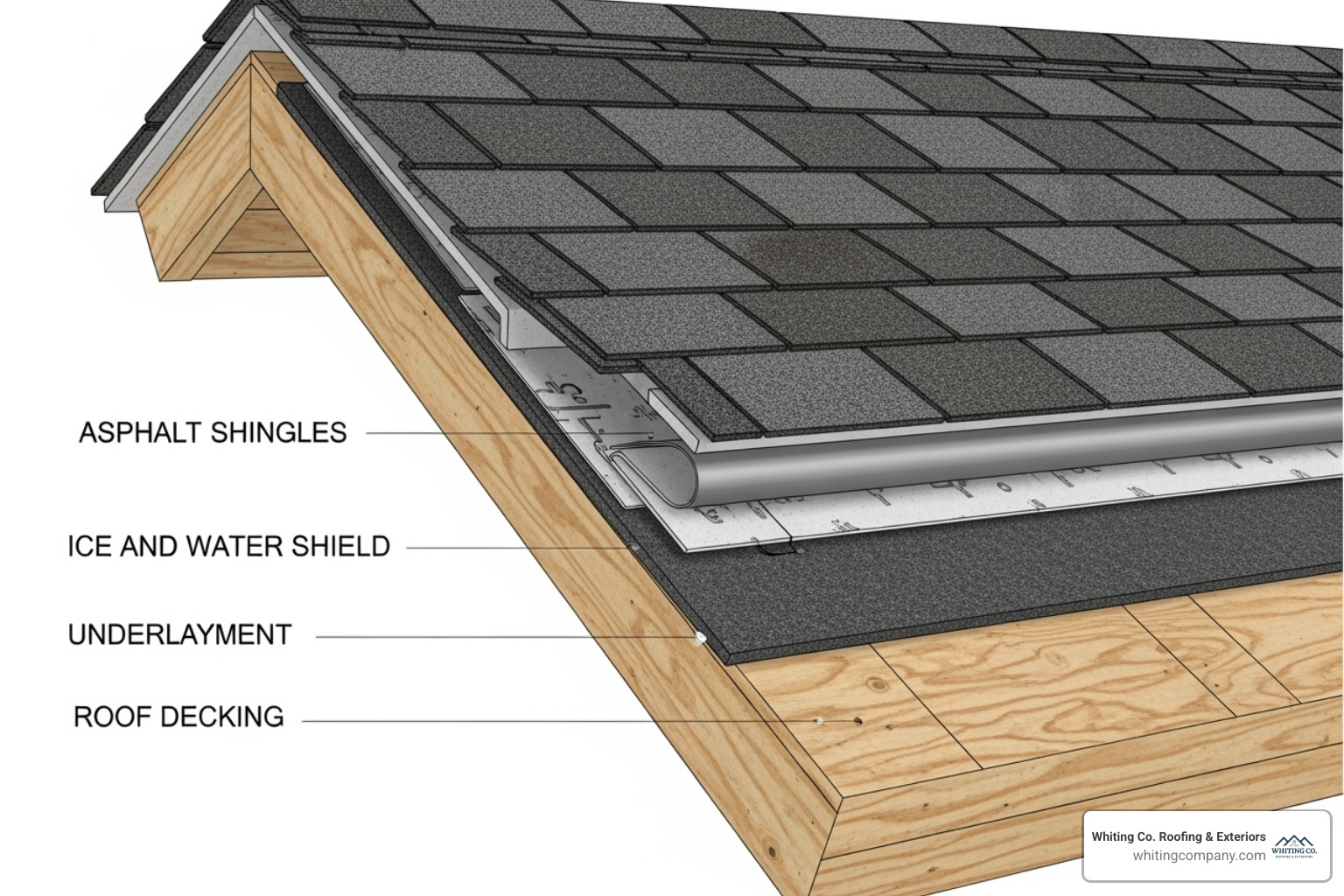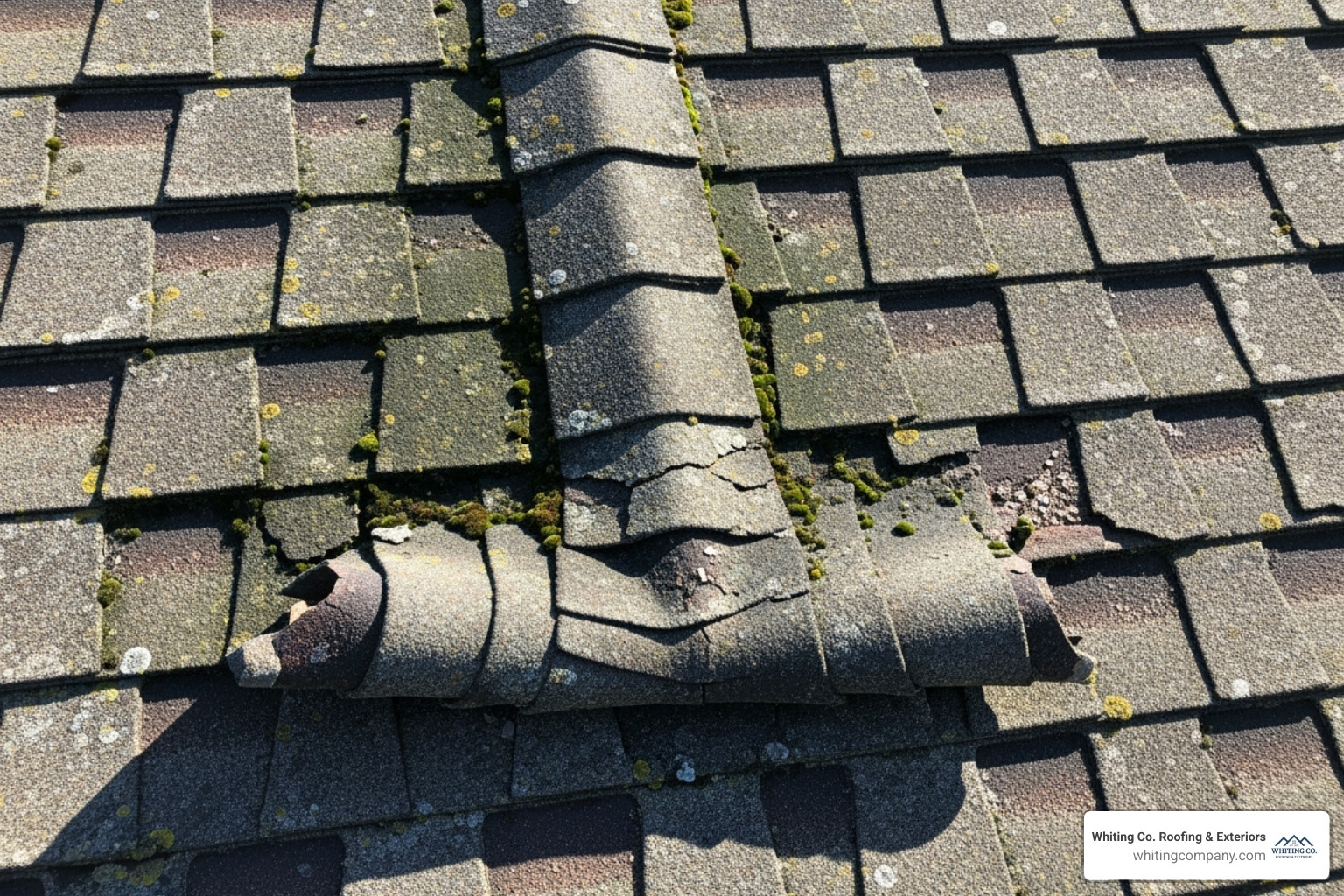Why Asphalt Shingle Roofing Matters for Your Home
Asphalt shingle roofing is the most popular residential roofing material in North America, covering an estimated 75% of U.S. homes. For homeowners looking for a quick guide to this essential home protector, here’s what you need to know:
- Composition: A layered material made from a fiberglass mat, asphalt, and mineral granules.
- Main Types:
- 3-Tab: A basic, single-layer shingle with a flat look and a 15-20 year lifespan.
- Dimensional (Architectural): A multi-layered, textured, and highly popular shingle with a 22-25 year lifespan.
- Luxury (Premium): The heaviest option, mimicking slate or wood, with a 30+ year lifespan.
- Key Benefits: Cost-effective, durable, a wide variety of styles, and easy to install and repair.
- Home Value: A new asphalt roof can yield a 61.1% return on investment, per the 2023 Cost vs. Value Report.
This guide from Whiting Co. Roofing & Exteriors covers everything about asphalt shingle roofing, from its components to its value. Understanding your options is key to protecting your Columbia, MD property from diverse weather.
With nearly 50 years of experience, my team at Whiting Co. Roofing & Exteriors delivers durable, high-quality exterior solutions custom for the Maryland, D.C., and Virginia markets.

Decoding Asphalt Shingles: Composition and Standards
Asphalt shingle roofing is a carefully engineered composite material designed as your home’s first line of defense. The secret to its performance lies in its multi-layered construction, making it the top choice for three-quarters of American homes.
The Core Materials: What Makes a Shingle
Every asphalt shingle is built on a fiberglass-based mat, which provides structural integrity and stability. In the U.S., nearly all modern shingles use this fiberglass base, a significant improvement over older organic-based shingles made from cellulose fibers.
This mat is saturated with a waterproof asphalt coating. This isn’t road asphalt; it’s specially formulated for weather resistance. Mixed into the asphalt are mineral fillers and stabilizers that improve fire resistance and flexibility, allowing shingles to withstand extreme temperatures without cracking.
The visible surface consists of colorful ceramic-coated granules. These granules protect the asphalt from UV ray degradation, which prevents premature aging. They also add fire resistance, and some specialty shingles include copper-infused granules to inhibit algae growth.
Finally, a fine layer of back surfacing, like sand, prevents shingles from sticking together in the bundle, simplifying the roofing materials installation process.
Industry Standards and Certifications
Asphalt shingles must meet rigorous industry standards for quality and safety. ASTM International is the leading organization setting these benchmarks.
- ASTM D3462: The key standard for fiberglass-based shingles, covering requirements for granule adhesion, weather resistance, and tear strength.
- ASTM D225: The standard for older, organic-based shingles.
Fire resistance is tested under standards like UL 790 and ASTM E108. A Class A rating is the highest level of fire protection available for roofing materials.
These certifications ensure the asphalt shingle roofing used for your roof installation has been proven to perform under real-world conditions, providing essential safety and performance.
The 3 Main Types of Asphalt Shingles
Choosing the right asphalt shingle roofing is a key decision affecting your home’s look, lifespan, and budget. The three primary types are 3-tab, dimensional, and luxury, with dimensional shingles being the most popular choice today.
1. 3-Tab Shingles: The Basic Choice

Recognizable by their flat, uniform appearance, 3-tab shingles were once the industry standard.
- Construction: A single-layer design makes them the lightest and thinnest asphalt shingle.
- Appearance: Their uniform shape creates a flat, repetitive pattern.
- Affordability: The most budget-friendly option, often used for entry-level housing or to match an older home’s aesthetic.
- Lifespan: Typically last 15-20 years and have lower wind resistance.
2. Dimensional (Architectural) Shingles: The Popular Upgrade
Also known as architectural shingles, these are the standard for modern asphalt shingle roofing. They feature two or more fused layers, creating a heavier, more robust shingle.
- Appearance: Their multi-layer construction provides a thick, dimensional look that mimics natural wood or slate, adding significant curb appeal.
- Popularity: They offer the best balance of cost, performance, and aesthetics, making them the most common choice.
- Lifespan: Last around 22-25 years with improved warranties and better wind resistance (often rated up to 130 mph).
3. Luxury (Premium) Shingles: The High-End Option
For homeowners wanting peak aesthetics and performance, luxury shingles are the top choice. They are the heaviest and most durable asphalt shingles.
- Appearance: Engineered to replicate natural slate or cedar shakes with deep shadow lines for a sophisticated, high-end look.
- Performance: They offer superior wind and impact resistance, ideal for areas with severe weather.
- Lifespan: Built to last 30 years or more.
Here’s a quick comparison:
| Feature | 3-Tab Shingles | Dimensional Shingles | Luxury Shingles |
|---|---|---|---|
| Lifespan | 15-20 years | 22-25 years | 30+ years |
| Appearance | Flat, uniform, traditional | Multi-dimensional, textured | High-definition, realistic |
| Cost | Most affordable | Mid-range | Premium |
| Wind Resistance | Basic | Good (up to 130 mph) | Excellent (superior ratings) |
| Popularity | Declining | Most prevalent | Growing |
More Than Just Shingles: The Complete Asphalt Roofing System
Your asphalt shingle roofing is more than just the visible top layer; it’s a complete system of integrated components. The hidden parts underneath are critical for water protection, durability, and longevity. A high-performance roof is one where every part works together to keep your home safe and dry.

Essential Under-Layers and Support
A strong foundation is crucial for a resilient roof system, especially in Maryland’s varied climate.
- Roof Decking: The structural base of the roof, typically plywood or OSB, that supports all other components. It must be sound and free of rot.
- Underlayment: A layer of water-resistant material (traditionally felt paper, now often synthetic) applied over the decking as a secondary moisture barrier.
- Ice and Water Shield: A self-adhering waterproof membrane installed in vulnerable areas like eaves, valleys, and around penetrations. It is essential for preventing leaks from ice dams and wind-driven rain.
- Starter Strips: The first course of shingles installed at the eaves and rakes. Their adhesive strip locks down the first row of shingles, improving wind resistance.
- Drip Edge: L-shaped metal flashing installed along roof edges to direct water away from the fascia and into the gutters.
Ventilation and Finishing Touches
Proper airflow and finishing details are vital for a long-lasting roof.
- Ridge Capping Shingles: Thicker, pre-formed shingles used on the peaks (ridges) and angled intersections (hips) of a roof to provide a finished look and prevent leaks.
- Attic Ventilation: A balanced system of intake (soffit) and exhaust (ridge) vents that allows hot, moist air to escape the attic. Proper ventilation prevents heat damage to shingles in the summer and moisture buildup that can cause mold or ice dams in the winter. It is essential for maximizing the life of your asphalt shingle roofing.
- Roof Flashing: Metal pieces installed around chimneys, skylights, and vent pipes to create a watertight seal and direct water away from these common leak points.
- Pipe Boots: Covers that fit snugly around vent pipes extending through the roof, providing another layer of watertight sealing.
By integrating all these components, we create a comprehensive roof system that performs exceptionally well, resists extreme weather, and protects your home for decades.
Lifespan, Value, and Warranties of Asphalt Shingle Roofing
Investing in asphalt shingle roofing is a major decision for your home’s protection and financial future. Understanding the roof’s lifespan, its impact on home value, and warranty coverage helps you make a confident choice.
How Long Does an Asphalt Shingle Roof Last?
The lifespan of an asphalt shingle roof depends on the shingle type, installation quality, and local climate. Here are typical expectations:
- 3-tab shingles: 15-20 years.
- Dimensional (architectural) shingles: 22-25 years.
- Luxury (premium) shingles: 30+ years.
Proper attic ventilation is critical to achieving these lifespans. Without it, trapped heat can “cook” shingles from below, drastically shortening their life. Quality installation and regular maintenance are also key.
Boosting Home Value with a New Roof
A new asphalt shingle roofing system is an investment that pays off. The 2023 Cost vs. Value Report shows that an asphalt shingle roof replacement delivers an impressive average ROI of 61.1%. This means a $25,000 roof could increase your home’s value by over $15,000.
Beyond the numbers, a new roof significantly improves curb appeal, making a home more attractive to potential buyers. It signals that the home is “move-in ready,” which can lead to faster sales and stronger offers.
Understanding Your Warranty Protection
Your roofing investment is protected by two types of warranties:
- Material Warranties: Provided by the manufacturer, these cover defects in the shingles themselves. Coverage ranges from 20 years for basic shingles to “limited lifetime” for premium products. It’s important to read the fine print, as coverage may be prorated over time.
- Workmanship Warranties: Offered by your contractor, this warranty protects against installation errors. Even the best shingles will fail if installed incorrectly, making your choice of an experienced contractor for your roof installation crucial.
Many manufacturers offer improved warranties when a certified contractor installs their complete roofing system. A roof replacement is not just a purchase; it’s an investment in your home’s future.
7 Signs It’s Time for a Roof Replacement
Waiting too long to replace your roof can turn a planned investment into a costly disaster. While a minor issue may only need a roof repair, widespread problems or an aging roof are clear signs it’s time for a full replacement. Recognizing these warning signs can save you from expensive interior damage.
Visual Clues from the Ground

You can spot many key warning signs from the safety of the ground.
- Curling or Cracked Shingles: When shingles curl at the edges or show cracks, they have become brittle from weather exposure and can no longer effectively shed water.
- Widespread Granule Loss: Look for dark, “bald” spots on your roof. These granules are the shingle’s armor against UV rays and water. Without them, the shingle deteriorates quickly.
- Dark Streaks or Algae Growth: Common in Maryland’s humid climate, these black streaks indicate that an aging roof is retaining moisture, even if the algae itself isn’t damaging.
- Missing Shingles: While a few missing shingles after a severe storm can be repaired, frequent loss indicates a failing roof system that can no longer withstand moderate winds.
- Sagging Roof Deck: A drooping or sagging roof is a serious structural issue that requires immediate professional attention, as it often points to water-damaged decking.
Issues Found During Inspection
A professional inspection can uncover deeper problems.
- Loose Granules in Gutters: A significant accumulation of shingle granules in your gutters is a reliable sign that your asphalt shingle roofing is actively deteriorating.
- Soft or Spongy Spots: These indicate that moisture has penetrated the shingles and compromised the underlying roof deck, creating a structural weakness.
- Age: A roof nearing or past its manufacturer-stated lifespan (e.g., a 20-year roof that is 22 years old) should be considered for replacement, even if it looks okay. Proactive replacement prevents emergency situations.
If you see these signs, it’s time to consider a full roof replacement. For more details, read our guide on Signs Your Roof Needs Repair.
Frequently Asked Questions about Asphalt Shingle Roofing
Here are answers to the most common questions we receive about asphalt shingle roofing from Maryland homeowners.
What are specialty asphalt shingles?
Specialty shingles are engineered to solve specific environmental challenges.
- Algae-Resistant (AR) Shingles: Ideal for Maryland’s humidity, these shingles contain copper granules to prevent the growth of unsightly black algae streaks.
- Impact-Resistant (IR) Shingles: Rated from Class 1 to Class 4 (highest), these shingles are built to withstand hail damage. A Class 4 rating may qualify you for a homeowner’s insurance discount.
- Cool Roof / Solar-Reflective Shingles: These shingles reflect solar energy to keep your attic cooler, reducing air conditioning costs. They may also be eligible for energy tax credits.
Can you install new asphalt shingles over old ones?
Installing new shingles over an old layer (a “roof-over”) is generally not recommended. A complete tear-off is the professional standard because a roof-over can hide underlying deck damage, adds excessive weight, and often voids manufacturer warranties. A tear-off allows for a proper inspection and ensures your new asphalt shingle roofing performs as intended and is fully warrantied.
How does Maryland’s climate affect an asphalt shingle roof?
Maryland’s climate requires a roofing system built to handle specific conditions.
- Humid Summers: Promote algae growth, making algae-resistant shingles a wise investment. The intense heat also makes proper attic ventilation essential to prevent shingles from overheating and aging prematurely.
- Heavy Rain and Winter Storms: A high-quality underlayment and an ice and water shield are critical for preventing leaks from wind-driven rain and ice dams, which occur when melting snow refreezes at the roof’s edge.
- Freeze-Thaw Cycles: Temperature swings can make shingles brittle. Heavier dimensional or luxury shingles are better equipped to handle this stress than basic 3-tab options.
At Whiting Co. Roofing & Exteriors, we design roofing systems specifically for these local conditions, ensuring your home is protected year-round.
Your Local Asphalt Roofing Experts
Choosing the right asphalt shingle roofing system is a critical decision for protecting your home. This guide has equipped you with the knowledge to make an informed choice, from understanding shingle types to recognizing the warning signs for replacement. You now know that a roof is an integrated system, not just the shingles you see.
For Maryland homeowners, the key to a long-lasting roof is partnering with a certified, local expert who understands our unique climate. At Whiting Co. Roofing & Exteriors, our team brings nearly 50 years of combined experience to every project. We know what it takes to build roofs that withstand Maryland’s hot summers and harsh winters.
As your local Maryland specialists, we design every asphalt shingle roofing system with custom solutions, from algae-resistant shingles to proper ice and water protection. When you work with us, you get more than a roof installation—you get a relationship built on trust and expertise, backed by comprehensive warranties.
Ready to explore the best roofing options for your home? Suspect it might be time for a replacement? Don’t wait for a small problem to become a costly emergency. Contact us for your Columbia, MD roofing project today! We offer a thorough, honest inspection and a free, no-obligation estimate to help you make the right decision for your home and budget.








